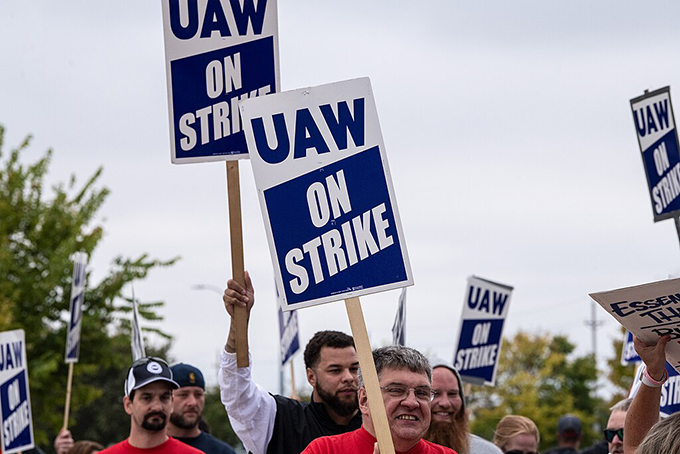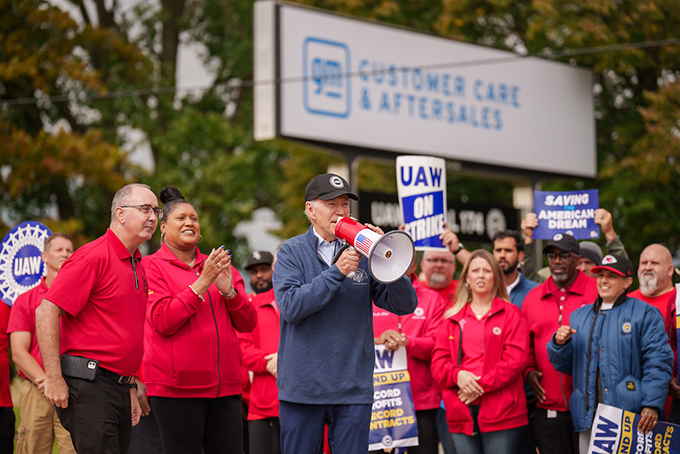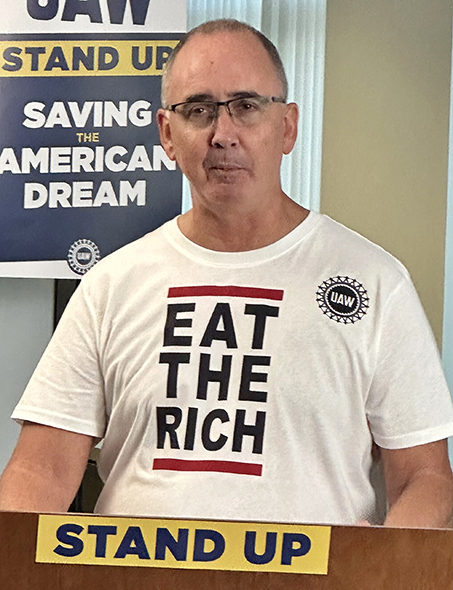“Get Up, Stand Up – Stand up for your right”*
By Peter Olney and Rand Wilson

“Stand Up” Strike Gives Autoworkers a Big Win
The “Hot Labor Summer” grew into an even “hotter” labor Autumn for the U.S. working class. The newly reformed United Auto Workers won historic contractual gains by selectively striking the “Big Three” domestic automakers: Ford, General Motors and Stellantis (a merger of Fiat, Chrysler, and Renault). On October 30, the union concluded tentative agreements with all three companies, pending membership ratification votes.
After decades of concessionary bargaining and “labor-management cooperation” that eventually led to financial corruption of top union leaders, the Unite All Workers for Democracy (UAW-D) reform movement won union leadership through the direct election by the members. The one-member, one-vote process for choosing leaders the result of a court settlement on corruption charges against the union and a referendum vote by the membership. UAW leaders were previously chosen at a convention where delegates were often controlled by paid staff from the union’s Detroit headquarters.
The new leadership took charge last March. Upon assuming office, they immediately faced the challenge of bargaining new contracts with the big three auto companies. These negotiations united 150,000 members — mostly employed in Michigan, Ohio, and Indiana.
With significant membership input, the new UAW leadership put forward dramatic demands for the new contracts:
- A 40% wage increase
- Four-day work week, with 40 hours pay
- Restore the Cost of Living Adjustment (COLA)
- Abolition of tiers
- The right to strike over plant closures
- Union jobs in future electric-vehicle (EV) plants where over $100 billion is expected to be invested in EV production creating as many as one million new jobs.
The reform slate’s dynamic new president is Shawn Fain — an electrician from Stellantis’ Kokomo, Indiana factory. During the strike, Fain framed the UAW’s contract battle in class terms, pitting autoworkers against wealthy corporate executives who have seen their compensation grow by 40% since the last agreement.
Fain relentlessly posed the question, what is the worth of workers vs. their employers? After the New York Times mocked his strong class stance, the next day he appeared wearing an iconic T-shirt that said, “Eat the Rich”!
The union called its strategy a “Stand Up Strike” in homage to the iconic 1937 “sit down” strike that birthed the union at General Motors. Back then, autoworkers at the Fisher Body Plant in Flint, Michigan sat down and occupied their plant, cutting off the supply of car bodies and paralyzing the General Motors production process.
On September 15, the union struck all three companies, but only at one of their key assembly plants – GM in Wentzville, Missouri; Ford in Wayne, Michigan; and Stellantis in Toledo, Ohio. Each factory was a “high profit center” for the respective company. These limited strikes allowed the union to conserve its $825 million strike fund which would only have lasted about 90 days if all members at the auto facilities were on strike. While at the same time leaving room for escalation or de-escalation based on the response of the individual companies at the bargaining table -the union conserved resources while keeping management off guard.

On September 22, the union escalated by striking 38 parts distribution centers in 20 states serving auto dealers for GM and Stellantis. The union’s strategy spared Ford because it had already conceded to demands that electrical vehicles be included under future national contracts and to the right to strike over factory closures. Expanding the strike to the parts warehouses broadened the exposure of the strike geographically, so that solidarity actions and media exposure could take place in far more states while also slowing the flow of parts to auto dealers.
On October 25, the UAW reached a tentative agreement with Ford. Three days later, it reached a tentative agreement with Stellantis, the parent company of the Chrysler, Jeep and Dodge Ram brands. The two deals contain the same or similar terms, including a 25 percent general wage increase for UAW members as well as cost-of-living wage adjustments if inflation flares.
“We have won a record-breaking contract,” the UAW’s Fain, said. “We truly believe we got every penny possible out of this company.”
Shortly after announcing the tentative agreement with Stellantis, the union expanded its strike against General Motors, calling on workers to walk off the job at the company’s plant in Spring Hill, Tenn. The plant makes highly profitable sport utility vehicles for G.M.’s Cadillac and GMC divisions.
The result at General Motors was predictable! The UAW boxed GM into a corner where, if it did not settle, its competitors would gain market share with their employees back on the job. Given that reality, GM settled on October 30 to terms substantially the same as Ford and Stellantis. The settlement includes the elimination of wage tiers at all three companies, so that some workers will see their wages double overnight. All joint venture battery plants will come under the master agreement. In a final brilliant touch, the UAW negotiated a May 1, 2028 expiration date. Announcing the agreement, Fain said, “We invite unions around the country to align your contract expirations with our own,” — a not too subtle call for a 2028 general strike!
With its major sectoral contracts concluded, UAW must now meet an even bigger challenge: Over one million auto workers, largely working for foreign-owned companies, are still not united in a union. Workers at major auto assembly plants owned by BMW, Honda, Hyundai, Kia, Mercedes, Nissan, Toyota, and Volkswagen — and their part suppliers — are working for less pay and far fewer benefits than their union siblings. Most of these companies are located in Southeastern United States where union density and power is below 10 percent. (Read more in the Nation)
The UAW clearly has the not-yet-union companies in their sites: “One of our biggest goals coming out of this historic contract victory is to organize like we’ve never organized before,” Shawn Fain said. “When we return to the bargaining table in 2028, it won’t just be with a Big Three, but with a Big Five or Big Six.”
Already, workers at Tesla’s manufacturing facility in Freemont California are forming a union organizing committee.
The UAW’s “stand up strike” demonstrated the strategic power of organized workers in key nodes of the economy. This revitalized autoworkers movement, along with this historic contract victory, gives us optimism that the difficult, but essential task of organizing more autoworkers is finally within reach.
*By Bob Marley and Peter Tosh
…

VIVA UAW! Be Wise Organize!
VIVA UAW! Be Wise Organize!